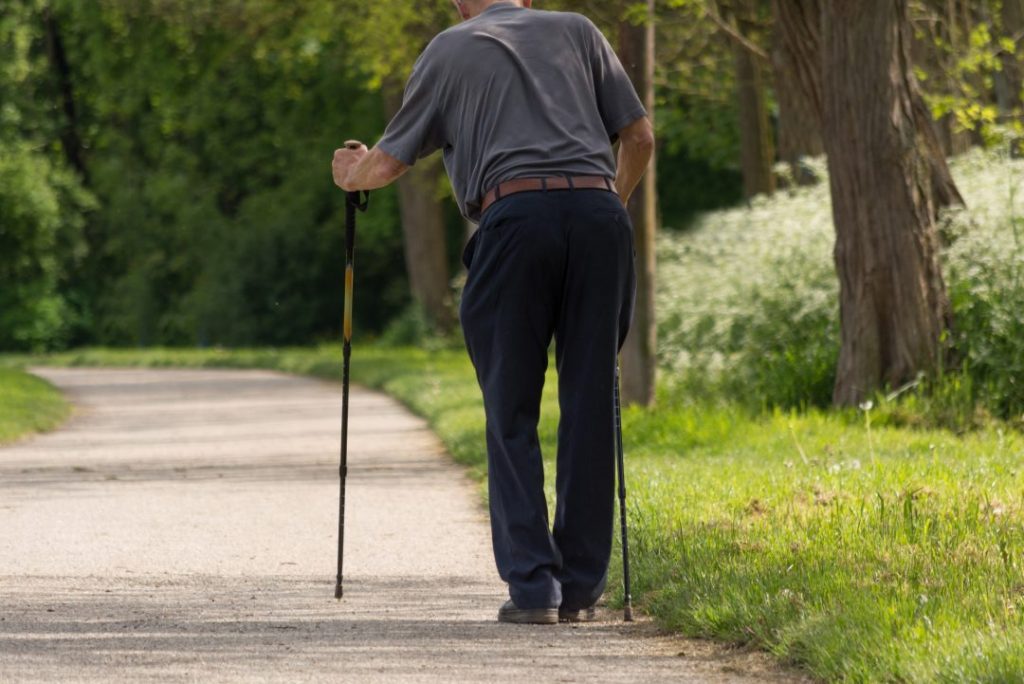
A person using a public sidewalk needing walking sticks for support and looking a little feeble and unsteady on his feet is the type of individual that may need our help for an aging in place renovation
Life has a way of playing little tricks on us. We think that just because something happened once or we experienced something, we can go back and relive it. We fondly remember a neighborhood where we grew up, for instance, and long to return there to live, but it’s not the same when we return to think about moving there.
Something is different. Maybe our perspective has changed. The filters that we use to view this scene from years later include life experiences that that former neighborhood has not encountered. It’s not a good fit anymore, and we can’t go back – at least not like it was. We may still like it for what it is and desire to live there still, but it will be for different reasons. We can’t really go back in time and relive what we felt then.
We can probably think of many similar instances where something seemed appealing or attractive to us at the time, but we decided that we couldn’t take advantage of it then. Later, when we were ready, it wasn’t available any longer or it didn’t feel like we thought it would. It was different. Think of a time when we were driving along on our way someplace and we spotted something of interest – a historical marker that we wanted to investigate, a pretty landscape or scene that we wanted to capture in a photograph, a roadside stand selling produce or local handmade merchandise, something for sale by owner that we spotted as we drove by, or other such examples – and we just kept driving.
We told ourselves that we would stop on the way back when we weren’t in such a hurry to get to our appointment or where we going. However, four things could have interfered with that plan. First, on our return trip, we were equally in a hurry to get to another meeting, return to our office, or take care of another matter that allowed us no time for sightseeing or stops like had thought we could do. Second, we returned along a different route and either forgot that there were one or two reasons we wanted to return the same way as we had gone or decided that the return route was quicker or provided other benefits. Third, we could not find the place we wanted to stop because it looked different coming from the opposite direction. Fourth, it didn’t look as nice when we stopped as it had appeared to us on our initial pass.
So, what does this mean about identifying and working with clients who need our services for aging in place renovations so they can continue living in their homes safely? The same principle applies. Often we see people whom we think could benefit from our services, We see them in public using a cane for support, taking very small steps and walking a little hunched over, struggling to carry or hold a package or bag they are trying to manage, sitting slowly or with obvious difficulty, standing the same way, getting in or out of their car (whether they are the driver or not) awkwardly, and other outward signs that they could benefit from out help if modifications haven’t already been done in their home.
However, we don’t know these people – we’ve never met them. So, while our concern for their well-being in relation to navigating their home and living well in it (assuming they still live on their own, which is probably a good assumption) is well-placed. We just aren’t prepared to act on it, or we figure that this is the right time or place to approach them. We keep moving, and we may just have missed an opportunity to help someone who really needs us. Will we see them again, can we find them on our later by looking for them, or will we ever get the opportunity to interact with them and learn how we can be of service? Most likely, no.
Without being too aggressive or out-of-line, we should try to engage people that we see who could use our help – to start a conversation and determine how they are doing in their homes. They could ignore us or tell us to get lost. On the other hand, they may welcome the introduction and ensuing discussion. We’re never going to know if we don’t make the first step.
There are other places and settings where we may view people that we think can use our help to provide grab bars, lighting, and other safety items just for starters. We might see them in their yard or on their porch as we are driving through their neighborhood. We may never get a second chance to approach some of these people we observe, and they may not seek or receive any help if we don’t make the gesture to reach out to them.
